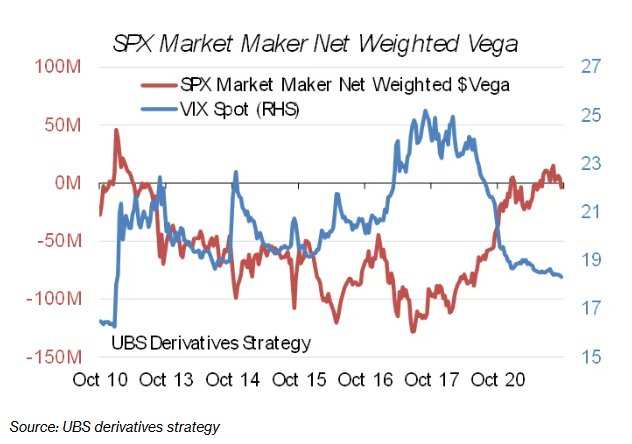VIX Sees ‘One-Day Surge,’ Leveraged ETFs May Become a New Market Risk

Over the past two weeks, even as the S&P 500 Index has remained relatively stable, volatility indicators have experienced a sharp rise followed by a rapid retreat. This has reignited discussions about market fragility—prolonged calm disrupted by sudden and excessive fluctuations.
According to Zhitong Finance APP, the U.S. stock market is not particularly volatile at present, but it appears fragile. In the past two weeks, even though the S&P 500 Index has moved relatively steadily, volatility indicators have surged sharply and then quickly retreated. This has reignited discussions about market fragility — prolonged calm interrupted by sudden and excessive fluctuations.
The latest example occurred on October 16. On that day, due to concerns over loan losses in regional banks, the S&P 500 Index fell only 0.6%, while the Chicago Board Options Exchange Volatility Index (VIX) soared to a six-month high. According to analysis by UBS Group strategists, the magnitude of VIX’s increase relative to the S&P 500 surpassed even the volatility events of August 2024, the “Volmageddon” episode of February 2018, and the aftermath of Lehman Brothers’ collapse in 2008. By October 17, however, the VIX had swiftly returned to its level from a few days earlier — before President Trump unsettled markets by threatening higher tariffs on China.
Kieran Diamond and other strategists at UBS Group noted that on October 16, market makers in S&P 500 index options became more “short” in their volatility positions as the market declined. When these positions were covered, it likely exacerbated the surge in the VIX. Additionally, traders may have held short positions in VIX call options, and hedging these positions also contributed to the rise in volatility.

In a report, strategists at Bank of America stated that the volatility on that day was more driven by technical factors. VIX-related exchange-traded products (ETPs) likely did not play a major role, as investors took profits when the VIX rose, while market makers covered their short positions. The strategists pointed out that in the case of a 10-point increase in the front-month VIX futures, only about 17% of long-volatility investors would need to sell their positions to offset traders’ rebalancing actions.
This pattern of “calm periods suddenly disrupted by volatility” also highlights the market “tug-of-war” phenomenon caused by the massive growth of trading products. On one hand, there are funds that suppress volatility by selling options to earn premiums; on the other hand, there are leveraged ETFs using swaps to track the returns of the S&P 500 and Nasdaq 100 indices, or recently established leveraged funds heavily concentrated in stocks with the largest influence on the index.
Garrett DeSimone, Quantitative Director at OptionMetrics, commented on the October 16 spike in the VIX: “When I think about the sharp fluctuations in the VIX and broader liquidity pressures associated with leveraged products, what worries me most is the potential risk of negative feedback loops triggered by the rebalancing of 2x and 3x leveraged ETFs.”
Leveraged equity ETFs have become a hot topic of discussion, especially regarding individual stocks like NVIDIA (NVDA.US) and Tesla (TSLA.US), which are highly favored by retail investors. The focus of the discussion is on the market impact of the daily rebalancing trades conducted by these funds, typically executed around the close, especially during periods of high volatility and thin liquidity.

According to estimates by Antoine Porcheret, Head of Institutional Structured Solutions for the UK, Europe, Middle East, and Africa at Citigroup, the notional size of global leveraged ETFs is approximately USD 160 billion, with the top ten stocks accounting for about 65%. In cases of significant market volatility, the trading volume of certain single-stock funds may represent 100% or even 200% of ‘closing auction volume,’ which can evidently impact prices. He noted that banks, as the ultimate counterparties to these funds through swap transactions, face equity risk exposure of around USD 300 billion due to leveraged funds.
However, this is not the only risk faced by banks. They are also exposed to so-called ‘gap risk,’ where they may incur losses while facilitating these trades. For instance, if a company declares bankruptcy, its share price could theoretically approach zero, causing a 2x leveraged ETF to lose 100%. Under such circumstances, the hedging positions held by the bank would effectively incur losses double that amount.

Banks typically hedge this gap risk by selling hybrid or standard derivatives to institutional clients. Unlike past crises, such risks do not linger on bank balance sheets for extended periods, as was the case during previous crises involving large exposures from holding variance swaps and other derivatives.
The risk today is more akin to ‘one-day fragility.’ In the current market landscape, prolonged periods of calm are often disrupted by flash crashes and rapid rebounds, potentially harming some participants. Garrett DeSimone stated, ‘I see several potential channels of contagion risk. Leveraged ETFs now manage a vast amount of assets, with a significant portion concentrated in the technology sector, which itself holds considerable weight in the S&P 500 Index.’






